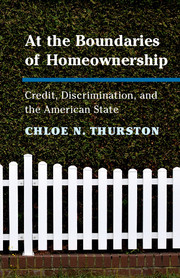Book contents
- Frontmatter
- Dedication
- Contents
- List of Figures
- List of Tables
- Acknowledgments
- List of Abbreviations
- 1 Politics, Markets, and Boundaries
- 2 Building a Government Out of Sight, 1932–1949
- 3 “To Create and Divert”
- 4 Breaching the Blockades of Custom and Code
- 5 Bankers in the Bedroom
- 6 From Public Housing to Homeownership
- 7 Markets, Marginalized Groups, and American Political Development
- Appendix: Archival Sources and Congressional Hearings
- Bibliography
- Index
4 - Breaching the Blockades of Custom and Code
Published online by Cambridge University Press: 25 May 2018
- Frontmatter
- Dedication
- Contents
- List of Figures
- List of Tables
- Acknowledgments
- List of Abbreviations
- 1 Politics, Markets, and Boundaries
- 2 Building a Government Out of Sight, 1932–1949
- 3 “To Create and Divert”
- 4 Breaching the Blockades of Custom and Code
- 5 Bankers in the Bedroom
- 6 From Public Housing to Homeownership
- 7 Markets, Marginalized Groups, and American Political Development
- Appendix: Archival Sources and Congressional Hearings
- Bibliography
- Index
Summary
After the National Housing Act of 1934 was signed into law, the Chicago Defenderpublished a note praising the “opportunity afforded by the Federal Housing Administration” and encouraging those who were interested to apply for FHA-backed loans. The article reassured its largely African American readership that “[i]t is believed that there will be no discrimination in local communities, and if such should be found to be the case you are advised to take up the matter with the officials at Washington through the congressman in your district.”
The Defenderhad reason to be hopeful. The hearings for the legislation that created the FHA contained no explicit discussion of race as a possible basis for inclusion or exclusion. True, the National Housing Act's deference to the private housing sector may have dampened the optimism of civil rights advocates, since many had long been aware of that sector's discriminatory practices. But federal involvement was initially enticing as a possible reprieve from the ravages of private discrimination, especially in northern cities whose populations had exploded as a result of the Great Migration.
Soon after the FHA's inception, it became clear that African Americans’ hopes for more equitable access to housing had been misplaced. To be sure, black homeownership rates increased steadily through the 1930s, 1940s, and 1950s, as they did for whites. Even so, there remained a persistent and growing gap between rates for black- and white-headed households, with homeownership rates for whites reaching 64 percent in 1950, versus 36 percent for blacks. The gap between black and white homeownership rates grew from 23 percentage points in 1920 to 28 points by 1960.
Nor was the increase in homeownership rates accompanied by a substantial change in the housing available to blacks. Developers hoping to build homes for African American or mixed occupancy continued to see their loan applications rejected. Prospective homeowners continued to find their options confined to secondhand (often deteriorating) houses in segregated neighborhoods. Segregation – and the way that it restricted competition on the basis of quality and quantity of housing – also ensured that even low-quality housing would remain expensive, at least more than comparable housing in white neighborhoods.
- Type
- Chapter
- Information
- At the Boundaries of HomeownershipCredit, Discrimination, and the American State, pp. 99 - 141Publisher: Cambridge University PressPrint publication year: 2018

